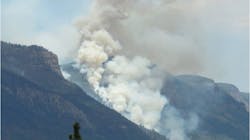A coal-fired train operated by Durango’s historic railroad spewed hot cinders that morphed last summer into the 416 wildfire, destroying 54,000 acres, crippling the local tourism economy and costing the U.S. government about $25 million to extinguish, a federal lawsuit contends.
After a year-long investigation, the U.S. Attorney’s Office in Denver filed suit Tuesday against the Durango & Silverton Narrow Gauge Railroad and its operator, American Heritage Railways Inc., on behalf of the U.S. Forest Service. The lawsuit blames the train for the fire and seeks approximately $25 million in suppression costs and other damages that are still being calculated, the U.S. Attorney’s Office said.
Federal fire investigators determined the June 2018 fire was ignited by burning particles emitted from an exhaust stack on one of the train’s iconic coal-burning engine locomotives, the complaint said.
RELATED:
“This fire put property at risk, put the public at risk and put the lives of firefighters at risk,” U.S. Attorney Jason Dunn told The Denver Post. “We’re going to pursue this within the best interests of the United States and the people who live in the area to make sure we do right by them.”
The railroad operator knows the risks and is liable for any fire damage, Dunn said.
The complaint alleges the train ignited multiple fires along the Durango-to-Silverton track in the months leading up to the June 1 fire. An intense drought had blanketed the state, and the 2018 wildfire season was intense.
The complaint also cited four previous fires caused by the train, dating back to 1994, that required federal fire-fighting resources to extinguish.
“Defendants’ coal-burning steam engines commonly cast off burning cinders and other hot materials, and, particularly under dry conditions, pose an extremely high risk of fire,” federal prosecutors wrote.
At about 9:53 a.m. on June 1, 2018, the train cast burning cinders or other hot material as it chugged up Shalona Hill, part of the San Juan National Forest, according to the complaint.The train engine had a metal screen over the exhaust stack to catch the embers, but it didn’t catch all the burning debris from flying out. Once the embers hit the ground, they ignited a brush fire next to the railroad tracks, investigators found.
The 416 fire quickly spread into the sixth-largest wildfire in Colorado history. The flames triggered thousands of evacuations, caused millions of dollars in damage to the local economy and shut down the San Juan National Forest for the first time in its 113-year history. Firefighters battled the blaze for two months before it was fully contained at the end of July.
Two residents said they saw the fire start moments after the train traveled through a drought-stricken canyon just north of Durango.
Al Harper, the railroad’s owner, previously has said he would take “whatever steps necessary to make it right” if the railroad is found to have caused the fire.
Dick Waltz, an attorney for the railroad, said he could not comment on the pending litigation.
The railroad and its owner are also facing a civil lawsuit from more than two dozens area residents and businesses, who claim the company acted carelessly by running its coal-fired train during an extreme drought.
The railroad has been a staple of Durango for nearly 140 years, delighting tourists from around the globe with its century-old trains. The picturesque ride brings travelers through the San Juan mountains from Durango to Silverton.
———
©2019 The Denver Post
Visit The Denver Post at www.denverpost.com
Distributed by Tribune Content Agency, LLC.






